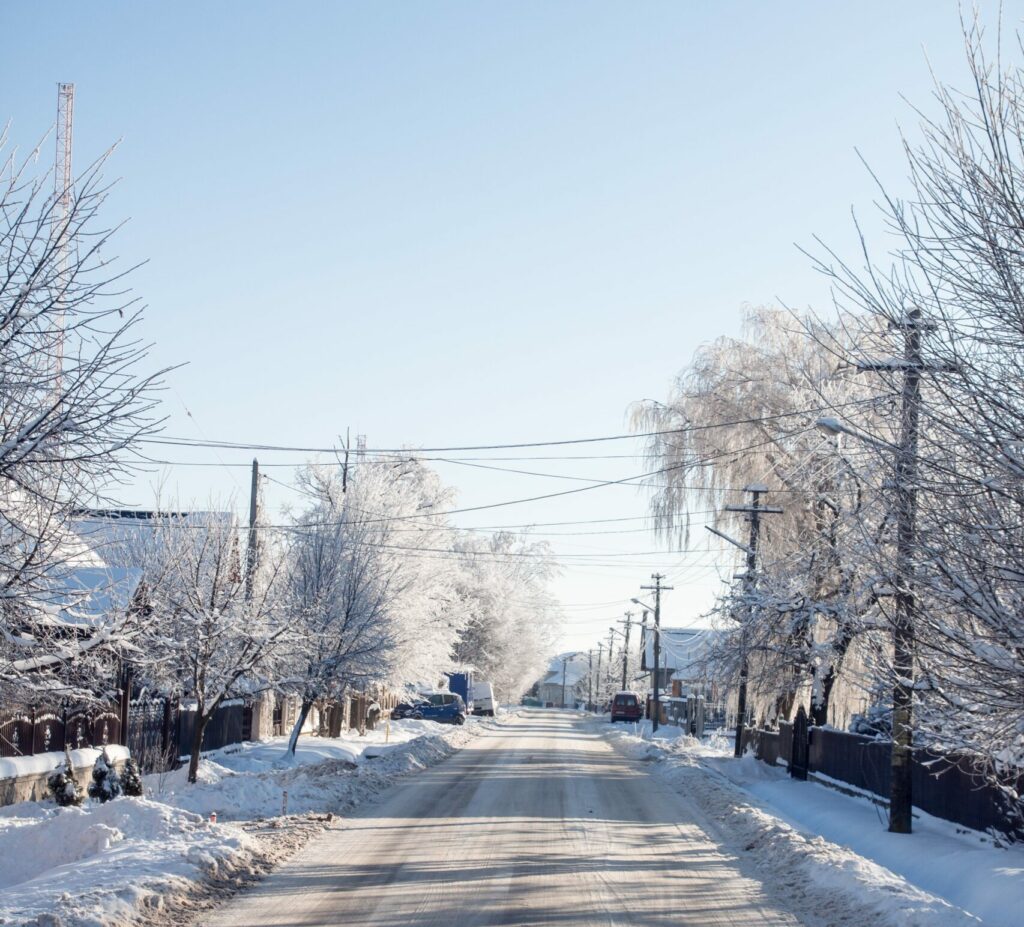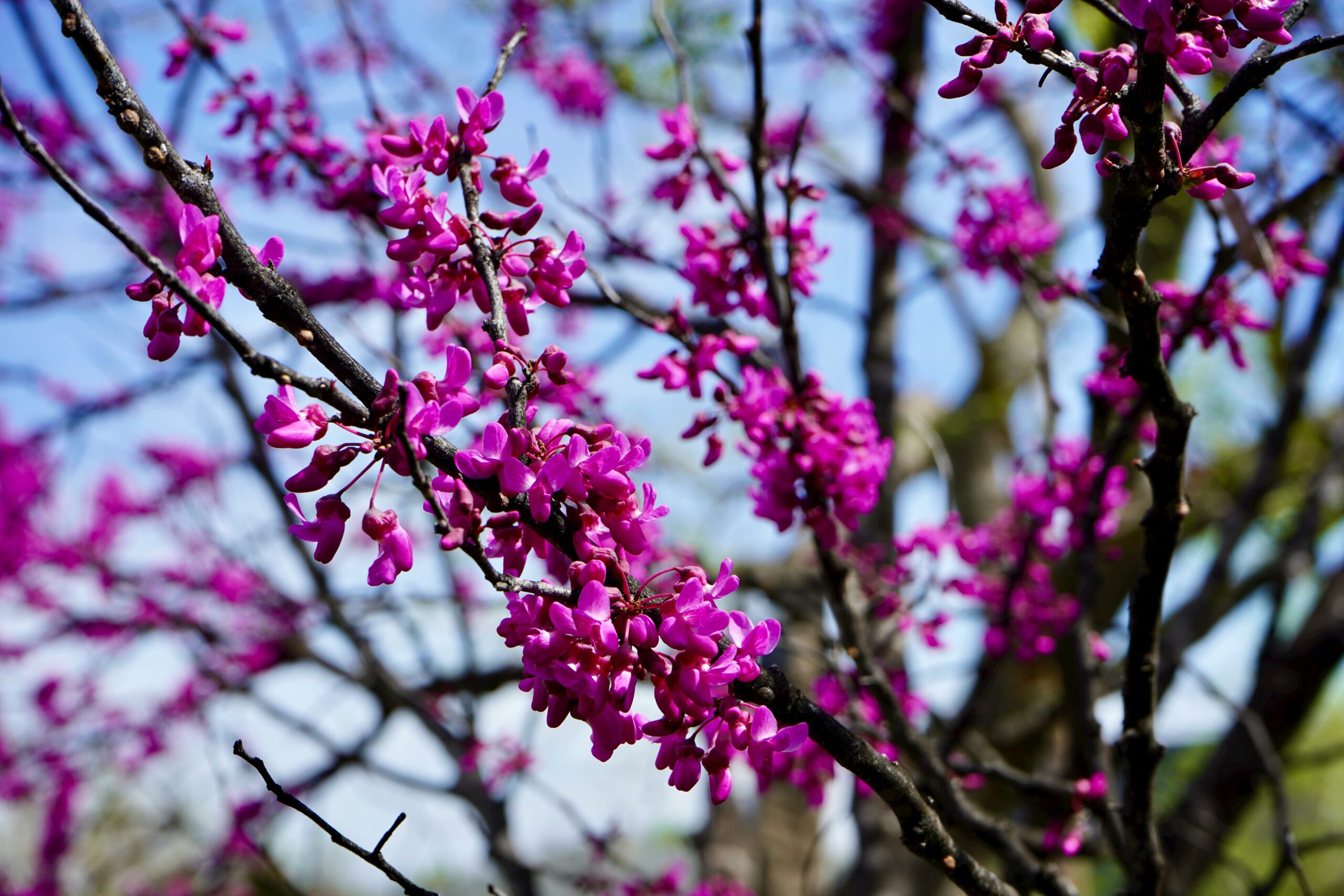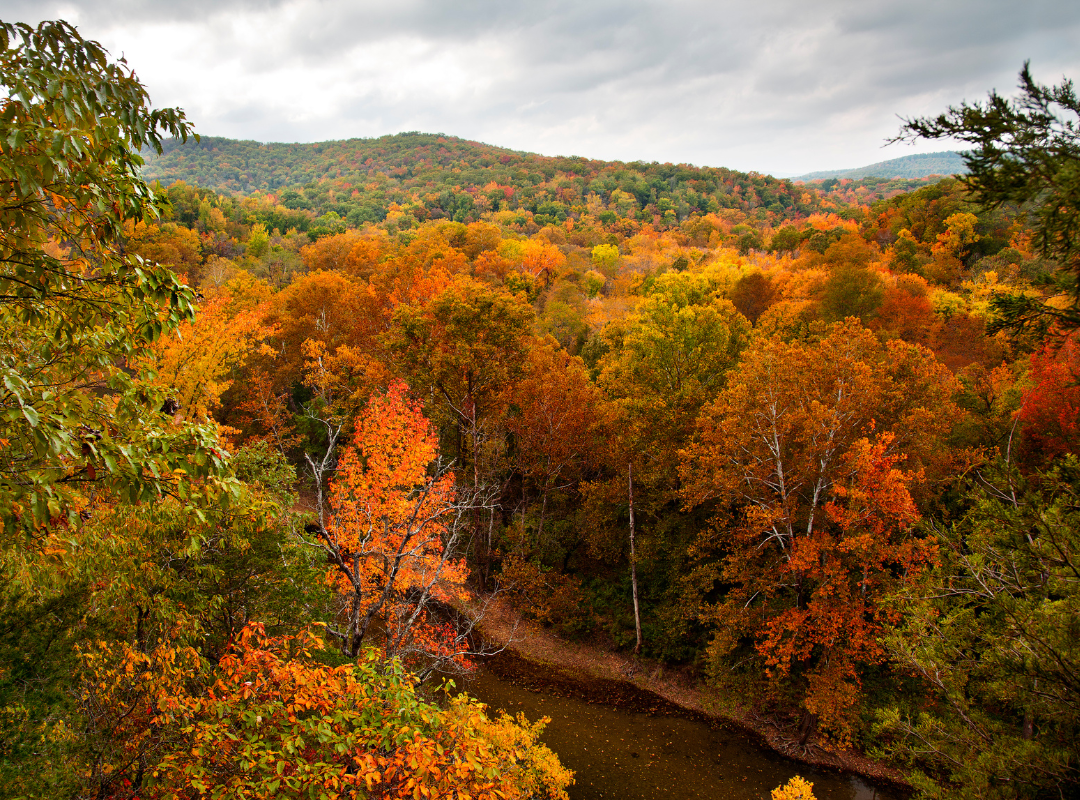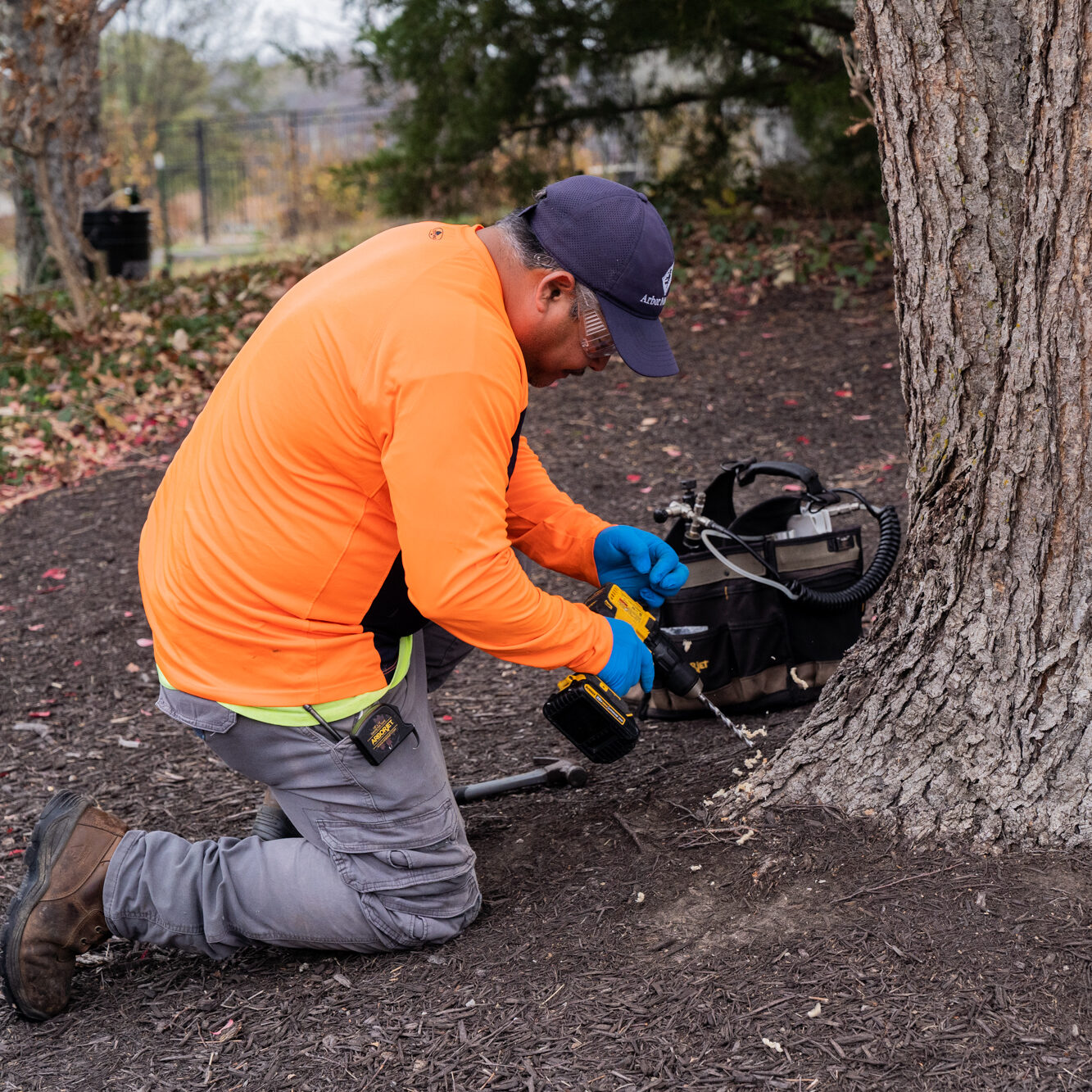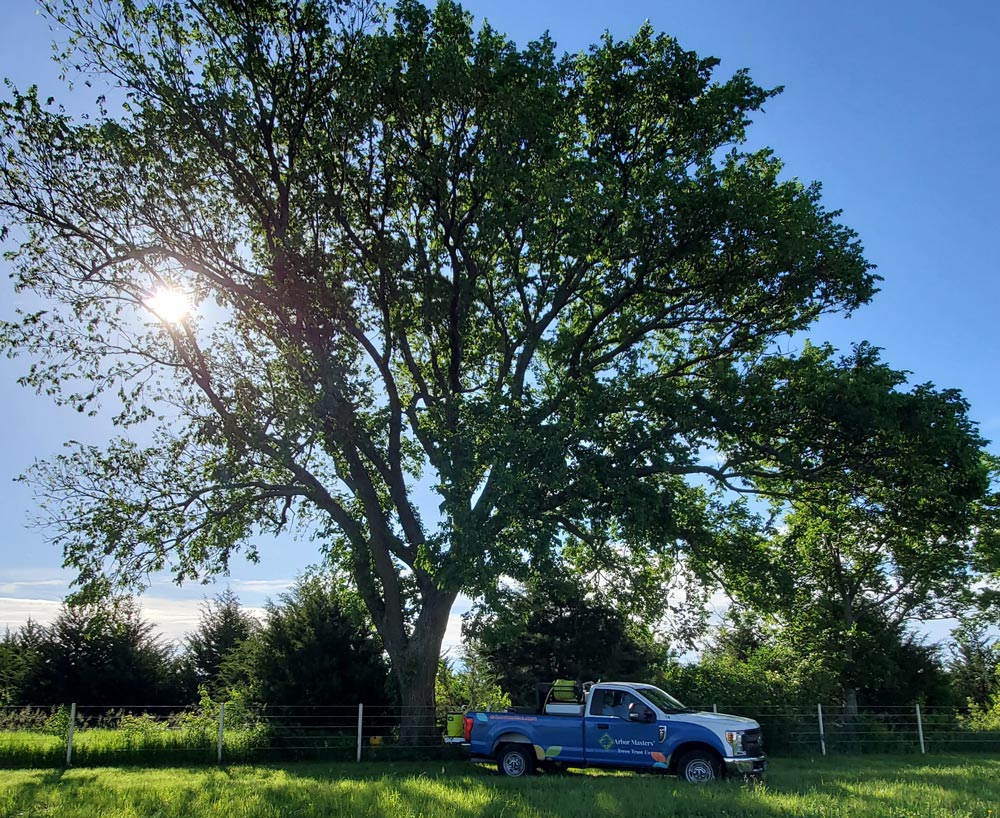Winter Tree Care: Debunking the Myth of Trees Not Needing Water
We’re all about looking after your trees year-round, which is why our team of tree experts, including certified arborists and some seriously skilled tree climbers and dedicated plant health care technicians, is on a mission to bust common myths about winter tree care. Let’s chat about one of these myths: the idea that trees don’t need a drink during the winter. In this blog, we’ll break it down and explain why it’s important to give your trees water during the chilly months to equip your trees to thrive in challenging growing conditions for years to come.
Understanding Winter Tree Watering
Contrary to popular belief, trees do require water during the winter. While their water consumption decreases, it doesn’t stop entirely. Trees continue to lose moisture through their needles and in some cases leaves, but at a slower rate, and they also take up water through their roots. Proper hydration is essential for their overall health and survival.
One reason why trees require water in winter is the ongoing transpiration process. Transpiration is the release of water vapor through a tree’s leaves. Even when the weather turns cold, trees continue to lose moisture through their leaves. This process, although at a slower pace compared to the warmer months, is essential for maintaining the tree’s physiological functions.
In addition to water loss through transpiration, trees also absorb water through their roots during the winter. While their metabolic activities are reduced, they don’t come to a complete halt. Water uptake through the roots serves several critical purposes:
- Nutrient Transport: Water carries essential nutrients from the soil to various parts of the tree. This nutrient flow is essential for basic functions such as growth, cell maintenance and energy production, which continue even in the winter months.
- Cold Protection: Water within the tree’s cells acts as a natural antifreeze, preventing cell damage when temperatures drop. Adequate hydration helps the tree resist the detrimental effects of frost and extreme cold.
- Root Health: Well-hydrated roots remain robust and are better equipped to withstand the challenges of winter, including freezing temperatures and soil moisture fluctuations.
- Stress Resilience: Proper hydration bolsters the tree’s ability to endure environmental stressors, such as unexpected temperature fluctuations or sudden temperature drops.
Signs of Dehydration in Winter Trees
Cold, dry air can desiccate evergreen foliage and exacerbate drought stress in all trees if they go into winter without adequate moisture. Dehydration in winter trees can have subtle yet significant consequences, impacting their immunity, susceptibility to diseases and overall stress levels. While the signs of dehydration may be less apparent during winter, it’s essential to remain vigilant and recognize these symptoms to provide timely care.
- Weakened Immune Systems: Dehydrated trees have compromised immune systems, making them less robust to pressures of diseases, pests and abiotic disorders such as mechanical injuries like mower damage and soil compaction.
- Susceptibility to Pathogens: Dehydration increases the likelihood of fungi, bacteria, virusesand other diseases taking hold in trees.
- Stress: Water-deficient trees are under stress, which reduces their resilience to environmental challenges.
Signs of dehydration may include wilted or discolored leaves, premature leaf drop and stunted growth. Recognizing these signs is vital for early intervention and effective winter tree care.
When to Water Your Trees in Winter
Timing is crucial when it comes to winter tree watering. It’s best to water your trees on days when the temperature is above freezing. Avoid watering when the ground is frozen, as the water won’t be able to penetrate the soil effectively. For region and soil-specific advice, consult local horticultural organizations, county extension offices, or certified arborists who understand the local conditions and can provide tailored recommendations.
The Value of Watering in Winter Tree Care
Watering is more than just giving plants a drink; it requires paying attention to specific details. Let’s dig into some key concepts that shed light on the intricate art of keeping our leafy companions properly hydrated.
- Soil Moisture Test: Before watering, conduct a soil moisture test by using a hand trowel or shovel to inspect the top six inches of soil. Avoid watering trees if the soil is already moist, as excessive moisture can be detrimental.
- Turf Irrigation Systems: Recognize that turf irrigation systems are not optimized for the deeper root systems of trees. Opt for less frequent but longer moisture applications to benefit trees, encouraging roots to grow deeper for water.
- Year-Round Watering: Even during seasons when irrigation is typically halted, trees still need moisture. A tree stressed by drought in winter becomes more vulnerable to dry spells in spring and summer.
- Temperature Considerations: Water when the ambient temperature is 40 degrees Fahrenheit or higher to ensure effective absorption by the soil.
- Volume Guidelines: Follow the general rule of applying 1-inch of water, which can be measured by placing a container under a sprinkler. Prefer less frequent, deeper watering, except for heavy clay soils with poor drainage.
- Soaker Hoses and Timing: Choose soaker hoses over overhead water application to prevent foliar fungus. Morning watering allows moisture to absorb and evaporate from foliage. Prioritize watering for young trees still establishing themselves.
- Seasonal Cessation: Cease watering when the ground freezes; the timing may vary across your property due to factors like shade and slope. Winter hydration reduces heat and drought stress on trees in the subsequent summer.
- Mulching Benefits: Mulch around the tree base to retain soil moisture, reducing the frequency and volume of watering required. Woodland trees naturally self-mulch through annual leaf drop, providing insulation against frigid temperatures and aiding in moisture retention.
Proper Winter Watering Techniques
To maintain your trees’ optimal hydration during the winter, it’s essential to employ the right watering technique. Generally, keep water low. Reduce the frequency of watering, avoid overhead irrigation and opt for low-impact sprinklers and drip hoses. For smaller trees, consider hand watering for optimal efficiency.
Deep-root watering is highly recommended, as it encourages robust root development and helps trees store water for the upcoming spring. By targeting the entire root zone rather than just the base of the tree, this method ensures that moisture reaches the deeper, more critical root zones where trees can access it most effectively.
Here’s how to perform deep-root watering for your trees:
- Choose the Right Equipment: Select a soaker hose or a regular garden hose with a low trickle setting. These tools are designed to deliver water slowly and evenly, preventing excessive runoff and allowing it to penetrate the soil effectively.
- Locate the Drip Line: The drip line is the outermost circumference of a tree’s canopy, where rainwater typically falls. This is where you’ll want to focus your watering efforts. Tree roots are concentrated in this area, making it the most beneficial spot for deep-root watering.
- Water Slowly and Deeply: Place the hose at the drip line and turn it on to a slow trickle. Allow the water to seep into the soil at a gradual pace. Slow and deep watering encourages roots to grow deeper into the ground, which promotes stability and resilience in the tree.
- Move the Hose Around: To ensure even moisture distribution, move the hose around the tree’s drip line. This helps prevent overwatering in one area and underwatering in another, creating a balanced and hydrated root system.
- Time Your Watering Sessions: During the dormant season, trees require less frequent watering compared to the growing season. You can typically water every few weeks, depending on weather conditions. Be mindful not to overwater, as excessively wet soil can lead to root rot and other issues.
Choosing the Right Trees for Your Climate
Selecting the right tree species for your region is essential in maintaining healthy trees during winter. Native trees are often better adapted to the local climate and require less intensive care. Consult with a local arborist to make the best choices for your area.
Here are examples of the right tree species for the regions we serve:
- Dallas/Fort Worth, Texas: Consider native species like the Texas Red Oak or Cedar Elm, which are well-suited to the hot and dry climate.
- Oklahoma City and Tulsa, Oklahoma: Opt for native trees such as the Eastern Redbud or the Oklahoma State Tree, the Redbud, for better adaptation to the local weather.
- Wichita, Kansas: Look into native options like the Hackberry or the Burr Oak, which can withstand Kansas’ diverse climate.
- Des Moines, Iowa: Consider native species like the Bur Oak or the Iowa State Tree, the Oak, which are adapted to Iowa’s varying climate.
- Kansas City region: Native trees such as the Shumard Oak or the Missouri State Tree, the Flowering Dogwood, are great choices for Kansas City’s weather.
Protecting Your Trees from Frost and Cold
In addition to watering, it’s important to protect your trees from frost and extreme cold. Mulching around the base of the tree helps insulate the roots and conserve moisture. Wrapping the trunks of young trees with tree wrap or burlap can prevent frost damage.
Benefits of Winter Tree Care
Proper winter tree care offers numerous benefits, including stronger, healthier trees in the spring. By tending to your trees during the colder months, you reap various benefits that ultimately lead to a more vibrant and resilient landscape. Here are some advantages:
- Enhanced Spring Health: By ensuring that your trees have sufficient moisture and nutrients during the dormant season, you promote healthy, vibrant foliage and encourage new growth when the warmer months arrive.
- Reduced Risk of Winter Injury: Proper care in the winter helps protect your trees from common winter injuries, such as frost cracks, sunscald and damage from ice and snow. By providing insulation and support, you mitigate the risk of these seasonal threats.
- Resistance to Pests and Diseases: Winter tree care strengthens the tree’s natural defense mechanisms, making it more resilient against common threats that emerge during the growing season.
- Improved Aesthetic Appeal: A beautiful landscape isn’t just for the warmer months. Well-maintained trees during the winter remain an attractive and essential part of your outdoor environment, adding visual appeal even in the dormant season.
- Long-Term Tree Health: Strong, healthy trees are more likely to withstand environmental challenges, adapt to changing conditions and live longer.
- Environmental Benefits: Healthy trees contribute to a healthier environment by absorbing carbon dioxide, releasing oxygen and providing habitat for wildlife. Winter tree care sustains these ecological advantages.
- Financial Savings: Preventative care in the winter can save you money in the long run. By addressing potential issues early, you avoid costly treatments or, in the worst case, tree removal and replacement.
- Peace of Mind: Knowing that your trees are well-cared for in the winter provides peace of mind. You can enjoy your landscape year-round without concerns about tree health and safety.
Common Mistakes to Avoid in Winter Tree Care
Avoid overwatering in winter, as this can lead to root rot. Remember that less is often more when it comes to winter tree care. Additionally, never water when the ground is frozen, as this can create ice and damage the roots.
Trust the Experts: Winter Tree Care for Resilient, Flourishing Trees
In the world of tree care, Trees Trust Us. By understanding the importance of winter tree watering, you can help your trees stay resilient and flourish throughout the year. If you have questions or need assistance with winter tree care, don’t hesitate to reach out to our team of certified arborists for expert guidance and support. Your trees will thank you for it!


